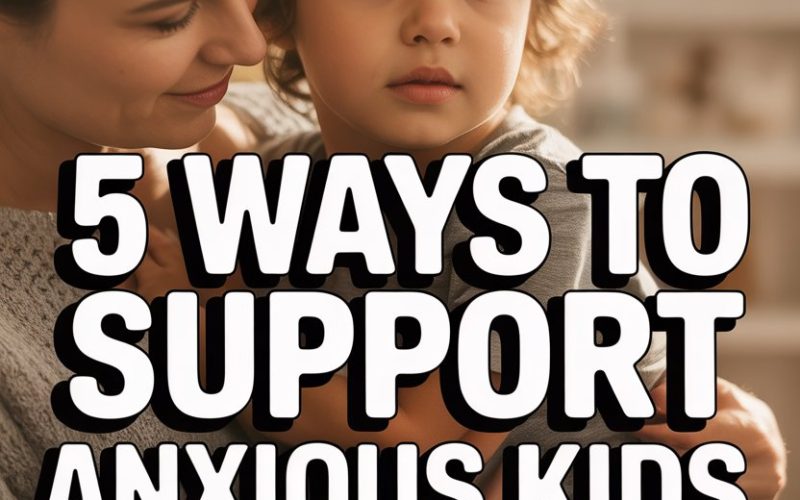Anxiety in kids can sneak up like a sock-stealing gremlin in the night.
One minute, your child is fine. The next, they’re worrying about everything from thunder to school plays to the mysterious fate of their favourite plush rabbit.
If you feel like you’re tiptoeing through a minefield of worries and “what-ifs,” you are not alone.
Busy parents don’t need a doctorate in child psychology to make a real difference.
Here are five gentle, totally doable ways to help your anxious child—without burning out.
1. Listen Like a Detective, Not a Judge
Children’s anxiety often sounds like a riddle wrapped in an enigma, delivered with tears and the emotional subtlety of a sledgehammer.
When your child comes to you upset, resist the urge to problem-solve straight away. No need to play “fix-it” hero in the first two minutes.
Instead, channel your inner detective—think Sherlock Holmes with less violin and more sippy cups.
Ask open-ended questions: “What’s making you feel worried right now?” Then wait. You might get a flood, or you might get silence. Both are okay.
Reflect back what you hear, even if it sounds a bit bonkers: “You’re worried the wind will blow our house away like in that pig story. That does sound scary.”
Validating feelings doesn’t mean agreeing with fears; it simply sends the message, “I get that this feels real to you.”
Experts from the Child Mind Institute stress that listening with empathy calms the emotional storm, making your child feel safe enough to share more.
2. Model Calm, Even If You’re Faking It
You know those safety briefings on planes? “Put your own oxygen mask on first.” Turns out, whoever wrote that was probably a parent.
Kids are emotional sponges, soaking up our mood—panic and all.
If you’re anxious, your child will pick up on it faster than you can say “awkward parent-teacher night.” Practice a deep, slow breath before responding to an anxious child.
Don’t stress about being a Zen master. Just try to avoid flapping about like a startled magpie.
When you feel your own heart racing, narrate your coping out loud: “I’m a bit worried right now, so I’m taking a deep breath.” Children learn by watching you.
Studies confirm that having a calm model nearby helps anxious kids regulate their own reactions.
And if you need to hide in the loo for a minute to regroup? You’re in good company. Some of us have chased serenity into the airing cupboard on more than one occasion.
3. Create Predictable Routines With Wiggle Room
Uncertainty can crank up anxiety faster than a toddler with a juicebox on a cream rug. Predictable routines help anxious brains relax, knowing what’s coming next.
It doesn’t have to be a military schedule—just a general flow: breakfast, play, school run, etc.
Visual timetables or checklists can be a game-changer, especially for younger kids or those who like to see what’s coming.
Teachers and child psychologists suggest using simple images or words for each chunk of the day.
Leave room for some flexibility.
If everything goes sideways because the cat was sick in the shoe basket, just talk through the changes: “We usually go to the park after school, but today we’re picking up Nana instead.”
And don’t forget rituals—tiny, predictable touchstones like a special goodbye handshake or a bedtime story. These moments are like warm slippers for the anxious brain.
4. Tame the Worry Monster Together
Anxiety can feel huge and mysterious—like a monster under the bed. Take the fear out of it by making worries concrete.
Sometimes, giving anxiety a silly name helps: “That’s just Worry Wilfred talking again.” Suddenly, the fear becomes something you and your child can face together, not an invisible menace lurking in the shadows.
Try the “worry box” trick. Decorate a box together, and when a worry pops up, your child can draw or write it down and pop it in the box.
Ritualising the release of worries helps kids feel like they’re taking charge. This is not just hocus-pocus; the University of Rochester recommends worry boxes as a way to make anxieties feel less overwhelming.
For older kids, try “worry time.” Pick a set time each day—say, just before dinner—when they have your undivided attention to unpack their anxieties.
Outside of that window, they can jot worries down, knowing they’ll be addressed soon. This teaches kids that worries don’t get to boss them around all day long.
5. Focus on Bravery, Not Avoidance
It’s incredibly tempting to shield your anxious child from every possible discomfort. Cancel the party, write the apologetic note to the teacher, never mention the word ‘dentist’ again. (Been there. Bought the sticker chart.)
The trouble is, anxiety shrinks when faced and grows when dodged.
Encourage small steps toward what makes your child anxious, with loads of praise for effort, not just results. “You felt nervous about going to soccer, but you got your kit on and went anyway. That’s brave!”
If you sense a meltdown brewing, break challenges into bite-sized pieces. “You don’t have to go into the whole classroom. Let’s just walk to the door together.”
Each tiny win is a notch on your child’s bravery belt.
The NHS and other mental health experts agree: Gradual exposure, mixed with heaps of encouragement, is the gold standard for helping anxious kids build confidence.
Avoid avoidance. It only gives anxiety squatter’s rights.
When Gentle Efforts Need a Little Backup
Supporting an anxious child is a marathon, not a sprint. Some days, gentle listening and a well-timed chocolate biscuit will work wonders.
Other days, your best-laid plans might be upended by a missing shoe or a surprise spelling test.
If your child’s anxiety is stopping them from doing things they enjoy or affecting their sleep, friendships, or family life, don’t hesitate to seek professional support.
Your GP, school counsellor, or a child therapist can offer tailored advice and extra tools for your kit.
You’re doing better than you think—even if you haven’t had a hot cuppa since 2018.
Your calm presence, gentle encouragement, and willingness to face the worry monster together send a powerful message: Anxiety is tough, but your child is tougher.
And no matter how stormy things feel, you’re right there in the boat with them—armed with love, routine, and possibly a pocketful of emergency biscuits.





